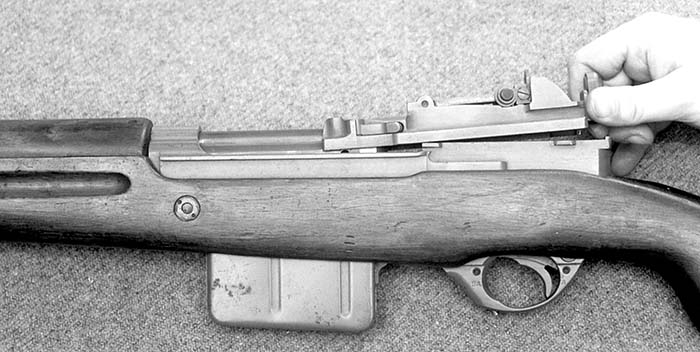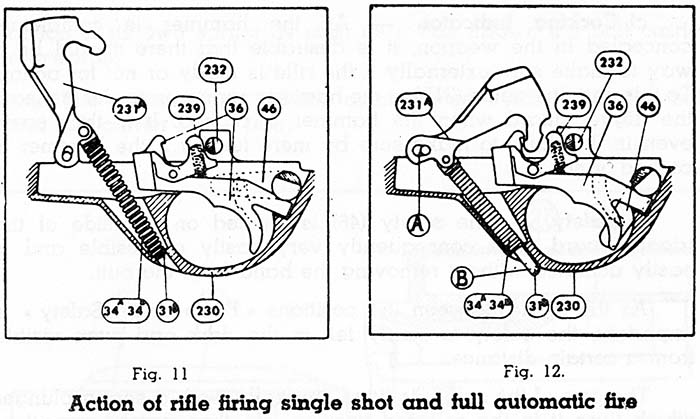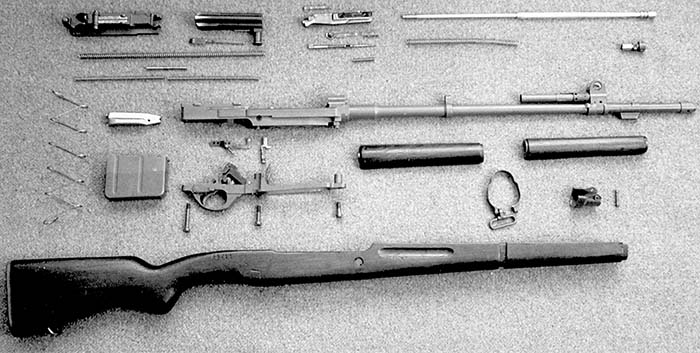By Brad Browne
History
The FN-49 rifle is a classic battle rifle. It was designed by Dieudonne J. Saive in the dark days before the Second World War. Saive fled Belgium prior to its occupation by Germany with his new design. Working at the Royal Arsenal at Enfield, he continued his design work throughout the war, but the British military showed little interest in changing from their proven Lee-Enfield rifles to a new, unproven semi-automatic rifle. So it was that when the war ended D. Saive returned home to Belgium to continue his work there for Fabrique Nationale.
The Belgian military adopted the FN-49 in .30-06, and the rifle was built in seven other different calibres, for a total of 11 different nations. Total production was 176,264 rifles. The production and distribution were as follows:
-6.5mm: 5 produced for testing
-7mm Mauser: 8,003 produced for Venezuela
-.30 M2 (.30-06): 125,072 produced for Belgium, Belgian Congo, Luxembourg, Indonesia, Colombia, and Brazil.
-7.5mm: 1 produced for testing
-7.62mm: 1 produced for testing
-7.65mm: 5,541 produced for Argentina
-7.92mm (8mm Mauser): 37,641 produced for Egypt and for British tests
There were variations on the original rifle including Sniper versions with a leather cheek pad, and the scope and mount. There were (rare) 20 round magazine versions produced.
The FN-49 saw action in the Korean War with the Belgian force in the UN contingent. Its performance was reportedly favorable in comparison to that of the M1 Garand rifle in use by the US forces.

Legal Status
The FN-49 could possibly fall under either the “Assault Rifle” provisions of the Crime Bill, or the National Firearms Act (Title II of the 1968 GCA), this depends on what features the rifle has. Since the rifle does exist in a selective fire configuration, those machine guns would require registration under the NFA. I don’t know if any NFA registered selective fire FN-49’s exist in the US. The rifle does fall under the provisions of the Crime Bill since it has a detachable magazine, it has a threaded barrel and a bayonet lug.
In Canada, the FN-49 is considered a non-restricted rifle, but due to Canadian laws, the FN-49’s 10 round magazine must be permanently blocked to five rounds or less. The new firearms control legislation in Canada requires the rifle to be registered (along with all other firearms) prior to 2003. Transfer of ownership is regulated by possession of a FAC (Firearms Control Certificate) or FPAL (Firearms possession and Acquisition License) and the transfer will cost $25. In Canada, only the Semi-auto version may be owned, unless the owner registered their select fire version in 1978.
Operation
The FN-49 is a gas operated, air cooled, magazine fed semi-automatic or fully-automatic rifle that fires from a closed bolt.
The gas system on the FN-49 is located above the barrel. There is a gas port 6.25 inches back from the muzzle that allows gas from the fired cartridge to be tapped off and directed into the gas cylinder. There is a threaded, adjustable sleeve around the gas cylinder that allows the amount of gas used by the system to be adjusted. This allows the extra gas to be vented, rather than sent through the system, allowing unneeded energy to exit the gas system that results in less wear and tear on the parts.
The breech block is a one piece tipping bolt, similar to the Tokarev SVT-38, SVT-40 and AVT-40 rifles. The breech block locks into place against a locking shoulder that is press-fitted into the receiver from one side. The breech block is cammed into and out of place by the breech block carrier. The breech block carrier has a spring guide in its upper portion, and it recoils on a double spring one inside the other. (The inner spring is actually two springs, joined in the middle by an internal spring guide rod.)

The trigger mechanism for the semi-auto version is different from that of the select fire version. The semi-auto version has only the trigger sear and the auxiliary sear. There is no provision for the installation of the safety sear, or the auto selector. There is a “Cocked” indicator that projects through the base of the trigger guard, near the front to indicate that the hammer is cocked back. The projection is useful for checking the status of the rifle in the dark.
The safety catch is located on the right-hand side of the trigger group. When engaged, the safety has two engagement points. The cross pin to which the safety is attached operates like an FAL safety with the flat plane and the rounded surface. The flat plane is cut so as to allow the trigger to move, then when the safety is rotated into position, the rounded portion physically prevents the trigger from moving. Additionally, on the side of the trigger is a milled groove in which a pin on the arm of the safety travels. When the safety is engaged, this pin locks in the groove and prevents the trigger from being able to move to the rear. Additionally, the arm of the safety catch blocks fingers from entering the trigger guard.
The semi-automatic version of the rifle has what is called the “Auxiliary sear.” This sear catches the hammer when it is re-cocked by the rearward motion of the breech block carrier, and does not release the hammer until the trigger is released.
The selective fire version of the rifle has an “Auxiliary sear” that operates the same as the semi-auto version, but with the activation of the Auto selector, the Auxiliary sear no longer engages the hammer when it is pushed down to re-cock. Instead, the “Safety Sear,” which is installed in the receiver engages a small notch on the right-hand side of the hammer. The Safety sear is tripped by an extension which engages with the breech block carrier when it is fully forward. In this fashion, the Safety sear will only release the hammer to fall when the breech block is in position and the breech block carrier is in battery. When the Auto selector is set to Semi-automatic, the rifle operates in the same fashion as the Semi-auto rifle, but with the additional protection of the “Safety sear” which still engages the hammer and prevents it from falling until the breech block carrier is fully forward.
The rifle may be used to fire rifle grenades, if the rifle grenade attachment is affixed to the end of the barrel. Prior to firing grenades, the barrel end cap must be put on (remove the muzzle brake if fitted) and the grenade launcher must then be attached. The launcher is attached to the barrel cap with a hinged clamp and a wing-nut. The gas plug must be rotated 180 degrees so that the “R” is visible instead of the “A.”

General
The rifle has a detachable 10 shot box magazine which does not retain the bullets when it is removed from the action. This is because the feed lips are integral to the receiver. This may seem odd to some, but considering that most contemporary rifles were 5-shot fixed magazines, this is not out of line with the thinking of the day. The magazine can be loaded singly, or with clips. The clips can be inserted into the charger that is integral to the top-cover of the rifle, and pushed down into the magazine. The FN-49 has a last-shot hold open device which locks open on an empty magazine. There is also a bolt hold open device so that the magazine can be topped off.
The receiver has a sliding dust cover that protects the opening into the receiver from the elements.
The sights are calibrated out to 1000 meters. The front sight is a blade protected by a set of ears. It is drift adjustable, similar to the Lee-Enfield front sight. The rear sight is a peep tangent sight which is adjustable for elevation and screw-adjustable for windage. This allows the rifle to be roughly sighted with the front sight, and the fine adjustments to windage are done from the rear sight.
There were several types of bayonets available for the FN-49, including 9” double edged daggers, and 15 inch single edged Mauser style bayonets. The 15” bayonets were used mostly by Venezuela, but both types of bayonet are considered to be correct for the rifle.
Field Stripping
Before Field stripping this (or any other rifle) MAKE SURE THAT THE RIFLE IS UNLOADED. Apply the safety catch, point the rifle in a safe direction and pull back on the charging handle to check that there are no bullets in the rifle. If there are no bullets in the rifle, the breech block carrier will lock to the rear on the empty magazine. If there are bullets in the rifle, continue to cycle the action until the magazine and chamber are empty, and the breech block carrier locks open on the empty magazine.
Close the breech by depressing the follower of the mag, pulling the breech block carrier slightly to the rear and slowly lower it.
At the upper rear of the receiver is a little tab. Swing it through 180 degrees so that it blocks the view through the rear sight. Doing this will also expose the cleaning rod hole that allows access to the bore.
Push the top cover forward about 1 cm (3/8”) and lift it up. It can now be brought to the rear. This will remove the top cover and the operating springs.
Next, grasp the cocking handle and pull the breech block carrier 8 centimeters to the rear. It can then be lifted out, bringing the breech block with it.
Flip the breech block carrier upside down and lift the breech block out. Lift from the front, and slide it to the rear to allow the lugs to slide out of their ways through the rear of the breech block carrier.
Taking the breech block apart requires a screwdriver, awl, bullet, or some sort of pointed tool. 2 cm (3/4”) from the front of the bolt, on the right-hand side is a groove. Insert the pointed tool into this groove and lift the extractor spring off the extractor. Rotate the spring down through 90 degrees.
Remove the extractor and set it aside.
Press in on the rear of the firing pin and lift the extractor spring out. This will free the firing pin and spring to come out the rear of the breech block. The firing pin safety stop (the little free-floating piece of metal in the top of the breech block) may be removed if necessary.
The magazine catch will release the magazine for cleaning.
To remove the gas piston, depress the catch on the gas cylinder plug and rotate it so that the catch faces toward the barrel. Pull it out, then slide the gas piston and spring out.
To reassemble the rifle, reverse this process. Ensure that when the gas cylinder plug is replaced that the “A” is facing up.

Example rifle
The rifle examined was a Belgian rifle in .30-06, produced by FN Herstal in Belgium. Serial number was 86711 with all parts matching. The rifle was in good condition, but the bore was slightly dark. The finish was nice grey Parkerizing, except for the breech block which appears to have been lightly blued.
There was a small amount of pitting and surface rust in a few spots (side of the magazine, dust cover, rear sight, and barrel nut were notable) but overall the finish of the rifle was good.
The wood is a dark walnut, and has its share of dings and scrapes, but no cracks were evident. There is a cast metal buttplate with a butt-trap and door, but the cleaning kit was missing. There was no sling included, no bayonet, and the combination tool was absent as well.
There was a scope rail milled into the left side of the receiver, but no scope was included, and from the lack of wear it would appear that no scope has ever been installed.
Upon disassembly of the rifle, the lack of wear, and the lack of carbon build up in the gas system indicates that the rifle has definitely fired less than 500 rounds, probably less than 250. The action has been hand cycled, but the breech block carrier shows little wear where the gas piston impacts.
The rifle examined is a select fire version of the FN-49, but the selector switch has been removed, so the automatic function could not be tested or evaluated.
To conform with Canadian legal requirements, the 10 shot magazine had been plugged internally to accept only five rounds.
Firing
The rifle was test-fired at the Nova Scotia Rifle Association’s Bull Meadow rifle range. The outdoor 100 meter range was selected. From the accompanying photos, it’s evident that winter has struck the range. The temperature was about -10 degrees (Celsius) on the afternoon that the firing was done. The rifle was given a pre-firing cleaning prior to departure for the range. The bore was cleaned and the action lubricated with Break-Free CLP.
The first group fired was 15 cm (6”) low and 10 cm (4”) left of the bull, but the group size was only 5.8 (2.25”) cm for the best four shots. The 5th shot opened the group to 13.6 cm (5.35”.) Corrections were made, but this was the best group of the day. The next two best groups were 11.4 cm (4.49”) and 11.6 cm (4.56”.) In each case, the 5th shot opened the group to more than 20 cm (8”.)
A total of 40 rounds of Winchester Super-X hunting ammunition (the only 30-06 available) was fired in this session. No jams or failures were noted throughout the session. The session was ended at dusk. Ejected cases were tossed about 2 meters forward and right of the shooter.
The author found the recoil to be more of a heavy push than a slamming impulse. The other shooter found the rifle to have considerably more recoil than the AR-15 that was also along that day, but did not find it excessive.
The accuracy attained during the shooting session may have been affected by the cold (rather, the author’s shivering might have affected the accuracy.) The first group, fired with warm hands and unfogged glasses is probably more reflective of the accuracy that the rifle is able to attain than the later groups.
Conclusions
The FN-49 was a very well built rifle for its time. Too well built in fact, since most of its parts are milled, rather than stamped. This means that the manufacturing costs for this rifle were very high. For this reason, it was unable to compete with more modern battle rifles.
This is not the end of the FN story, however, for Saive went on to help design and build the FN-FAL, one of the most prolific battle rifles in the world. The lineage of the FAL can be traced back directly to the FN-49, from the adjustable gas system, to the tipping bolt and headspacing method. Monsieur Saive’s Model 49 rifle was not the end, rather it was a beginning.
Author
I’m a Naval Electronics Technician (Acoustic) in the Canadian Navy (yes, we do have a Navy.) I’ve spent the last six years with the Navy Rifle team, and have shot at the Canadian Nationals several times, and have had the privilege or representing Canada and the Navy at Bisley in 1996 and 1997 with the Canadian Forces team. If you have any questions or comments for me, please feel free to contact me via e-mail, my address is: coffee@ns.sympatico.ca If I don’t know the answer, I’ll try to find it.
References:
Small Arms Of the World.
E.C. Ezell.
Stackpole Books, 1983.
PP 263, 264
Rec.guns FAQ: III.D.2.b.615.
Fabrique Nationale FN-49
John Landry. 1998.
http://www.recguns.com/IIID2b616.html
Nova Scotia Rifle Association
(902)-456-7468
| This article first appeared in Small Arms Review V2N8 (May 1999) |










